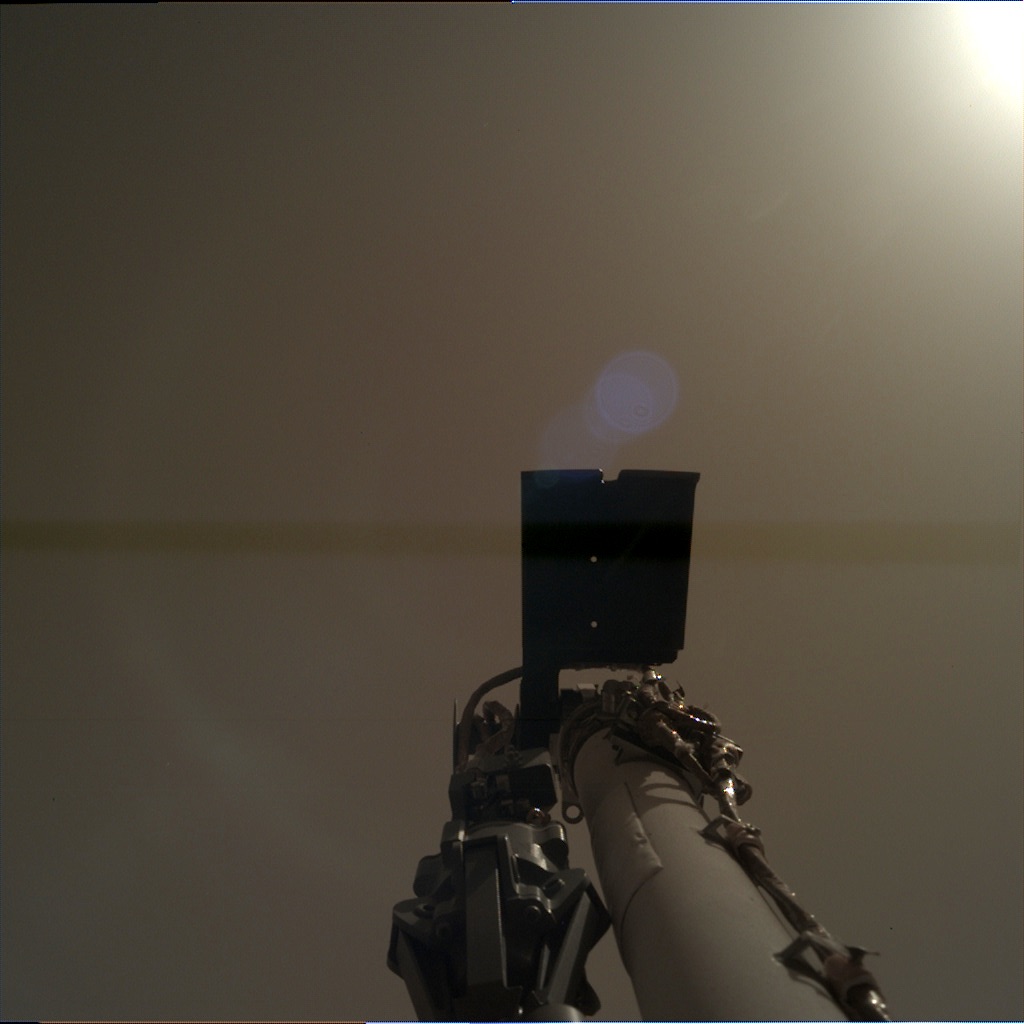NASA's Insight Mars Lander Raises Robotic Arm in Touchdown Triumph Photo

The InSight Mars lander apparently celebrates success with a simple, sustained arm raise.
NASA's newest Red Planet explorer snapped a photo of its own robotic arm standing upright against a ruddy-brown sky on Nov. 30, just four days after nailing its touchdownon the equatorial Martian plain called Elysium Planitia.
The image was taken by InSight's Instrument Deployment Camera, which is situated about two-thirds of the way down the lander's 5.75-foot-long (1.8 meters) arm. The black rectangle at the top of the picture is a scoop, and the arm's claw-like grapple hangs below, pointing toward InSight's deck. [NASA's InSight Mars Lander: Amazing Landing Day Photos!]
That five-fingered, wax-actuated grapple is vital to the success of InSight's $850 million mission, which seeks to map the interior of Mars in unprecedented detail. The lander will use the claw to place its two main science instruments — a burrowing heat probe and a suite of seismometers — directly on the red dirt of Elysium Planitia. InSight will also put a thermal and weather shield over the seismometers, which are so sensitive that they can detect seismic waves with the amplitude of a single atom.
The stationary lander won't be ready to begin these deployments until two to three months after landing, NASA officials have said. The mission team wants to study InSight's environs in depth for a while, to make sure they pick the right deployment spots and have practiced the crucial moves sufficiently. That practice is done using a test-bed lander at the mission's home base, NASA's Jet Propulsion Laboratory in Pasadena, California. (The scoop is pretty much for emergencies only, in case InSight needs to do some landscaping to ease deployment. Mission team members have said they don't expect to use it.)
The measurements InSight makes over the next Mars year (nearly two Earth years) should help scientists better understand how rocky planets in general form and evolve, NASA officials have said.
Elysium Planitia lies about 340 miles (550 kilometers) from Gale Crater, which NASA's car-size Curiosity rover has been exploring since August 2012. Curiosity has been a very supportive older sibling, welcoming InSight to Mars and congratulating the lander for ticking off important milestones (all on Twitter, of course).
Get the Space.com Newsletter
Breaking space news, the latest updates on rocket launches, skywatching events and more!
"Put your robotic arms in the air, make 'em stay there! All @NASAInSight does is win. Check out this new pic of arm and scoop from my new neighbor on #Mars, plus a bunch more raw images: http://go.nasa.gov/InSightRaws," the Curiosity team said on Nov. 30 via the rover's Twitter account, highlighting InSight's raised-arm photo.
Mike Wall's book about the search for alien life, "Out There" (Grand Central Publishing, 2018; illustrated by Karl Tate) is out now. Follow him on Twitter @michaeldwall. Follow us @Spacedotcom or Facebook. Originally published on Space.com.
Join our Space Forums to keep talking space on the latest missions, night sky and more! And if you have a news tip, correction or comment, let us know at: community@space.com.

Michael Wall is a Senior Space Writer with Space.com and joined the team in 2010. He primarily covers exoplanets, spaceflight and military space, but has been known to dabble in the space art beat. His book about the search for alien life, "Out There," was published on Nov. 13, 2018. Before becoming a science writer, Michael worked as a herpetologist and wildlife biologist. He has a Ph.D. in evolutionary biology from the University of Sydney, Australia, a bachelor's degree from the University of Arizona, and a graduate certificate in science writing from the University of California, Santa Cruz. To find out what his latest project is, you can follow Michael on Twitter.









